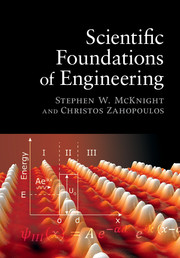Book contents
- Frontmatter
- Contents
- Introduction
- 1 Kinematics and vectors
- 2 Newton's Laws, energy, and momentum
- 3 Rotational motion
- 4 Rotation matrices
- 5 Materials properties: elasticity
- 6 Harmonic oscillation
- 7 Waves
- 8 The quantum puzzle
- 9 Quantum mechanics
- 10 Quantum electrons in atoms, molecules, and materials
- 11 Quantum electrons in solids
- 12 Thermal physics: energy, heat, and thermodynamics
- 13 Quantum statistics
- 14 Maxwell's equations and electromagnetism
- 15 Electromagnetic waves
- 16 Electromagnetic materials
- 17 Fluids
- Bibliography
- Index
12 - Thermal physics: energy, heat, and thermodynamics
Published online by Cambridge University Press: 05 September 2015
- Frontmatter
- Contents
- Introduction
- 1 Kinematics and vectors
- 2 Newton's Laws, energy, and momentum
- 3 Rotational motion
- 4 Rotation matrices
- 5 Materials properties: elasticity
- 6 Harmonic oscillation
- 7 Waves
- 8 The quantum puzzle
- 9 Quantum mechanics
- 10 Quantum electrons in atoms, molecules, and materials
- 11 Quantum electrons in solids
- 12 Thermal physics: energy, heat, and thermodynamics
- 13 Quantum statistics
- 14 Maxwell's equations and electromagnetism
- 15 Electromagnetic waves
- 16 Electromagnetic materials
- 17 Fluids
- Bibliography
- Index
Summary
Which has more internal energy: a pot of boiling water or the air in the room? This question is a good way to begin to talk about thermal phenomena. First, it introduces the concept that heat is a form of energy – the equivalence of energy and heat is the foundation of the First Law of Thermodynamics. Second, the answer depends on understanding the difference between average kinetic energy of molecules – which is what we measure by temperature – and the total internal energy of a system of molecules – which is changed by adding or removing heat. The water molecules in the pot have a higher average energy, but there may be fewer molecules in the pot than in the room air. We will be developing quantitative techniques to address this problem in this chapter, but first we need to consider the concepts of thermal equilibrium and heat capacity.
Thermal equilibrium
The first scientists who developed thermometers in the sixteenth and seventeenth centuries were surprised to find that different objects in their labs were all at the same temperature. When we touch objects that feel cold, what we are sensing is that they conduct our body heat away faster. Thus metal objects feel cooler than wood or cloth objects, but, in fact, to the first approximation everything in the room is at the same temperature, “room temperature.” This is because the room is an example of a system that is in – or near – thermal equilibrium.
The temperature is a measure of the average kinetic energy of the molecules in the system. If an object at a higher temperature comes in contact with a lower temperature object, energy will flow from the higher temperature object to the lower temperature object. This process goes on until the two objects are at the same temperature. All the objects in the room are in contact with the air and, through the air, in indirect contact with all the other objects in the room. The definition of thermal equilibrium is a system in which all the component objects are at the same temperature.
- Type
- Chapter
- Information
- Scientific Foundations of Engineering , pp. 212 - 254Publisher: Cambridge University PressPrint publication year: 2015



